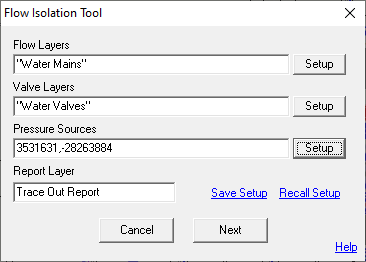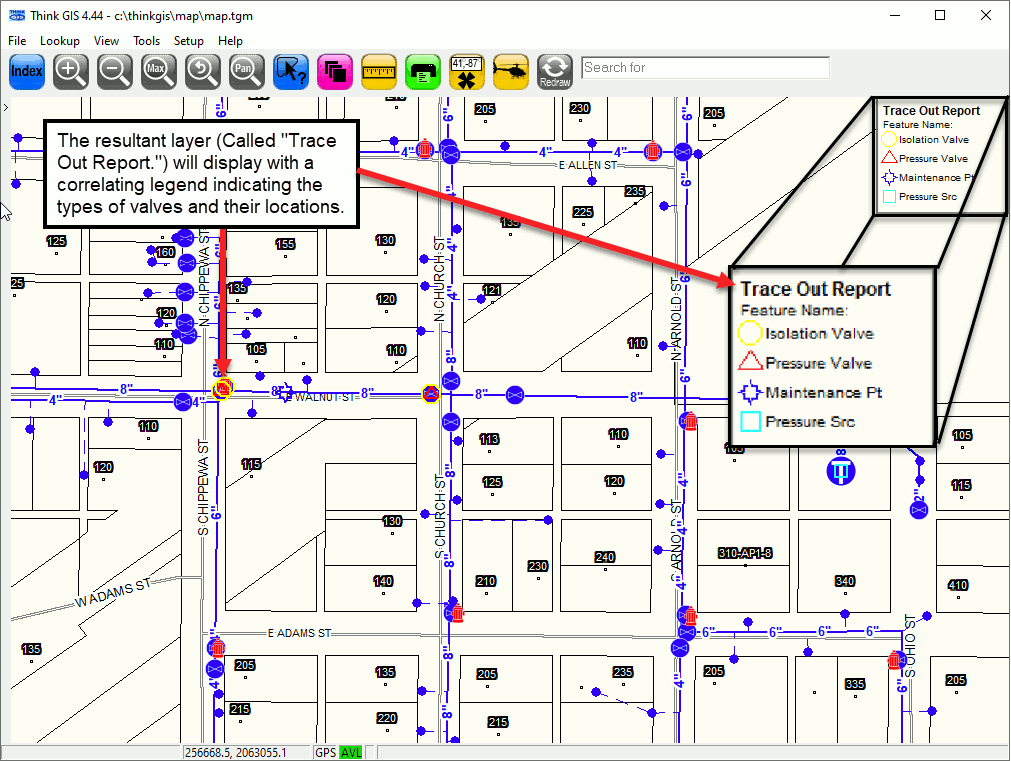
|
Flow Isolation |
This tool, located on Tools Menu > Show Map Editing Tools > Advanced Tools > Reporting, lets a user indicate a point on their line network that needs isolated, such as a point of rupture or point of maintenance. It then identifies the valves that need closed in order to isolate that section of pipe. The concept works well for gas, water, and electric utilities. The network is considered to be a pressurized network in that it assumes that flow can occur in any direction.
When running this tool, users will first be presented with the following setup screen.

After clicking next, users will be prompted to pick the point on the network that needs isolated. The analysis will then be performed and a report layer will be created showing the valves that need closed.

Flow Layers
Select one or more layers that contain the polylines that define the network. Polylines are only considered to connect if they meet at an end point. Use the Trace Out tool to check polyline connectivity.
Valve Layers
Select one or more layers that contain valves for this network. Any symbol on these layers will be considered a valve. Valves must be located at polyline end points.
Pressure Sources
This is an optional setting used to differentiate pressurized valves from non-pressurized valves. Pressure sources can include pumps, water towers, connection points to neighboring utilities, or any point location that can add pressure to the network. When no pressure sources are indicate, Think GIS will simply calculate the minimum number of valves that need to be closed to completely isolate the point of interest from the rest of the network. When one or more pressure sources are identified then Think GIS will still report the same isolation valves as described above but it will also report which valves are most critical because of being pressurized. In some cases the pressurized valves are a smaller subset of the isolation valves due to network dead ends and other conditions.
Report Layer
The report layer name to be created. If a layer by this name already exists it will be replaced.
Save and Recall Setup
Use the save and recall setup links to manage multiple configurations of this tool for use on different networks. This makes it easier to switch between running this tool on the water network to running the tool on the gas network without having to re-setup all the layers and pressure sources. Think GIS will automatically save the last used settings for this tool, so if there is only one utility network to use this tool on, then there is no need to save and recall settings. The process of recalling a previously saved configuration can be further automated through the use of the IsolationTool command. See list of commands for details.
Resulting Report
The resulting layer created by this analysis highlights 4 types of points:
•Maintenance Point - The point that needs isolated
•Isolation Valves - the minimum set of valves that need to be closed to completely isolate the maintenance point from the rest of the network
•Pressure Valves - the minimum set of valves that need to be closed to depressurize the maintenance point.
•Pressure Sources - Any pressure source points defined in the setup
|
Copyright © 2025 WTH Technology |